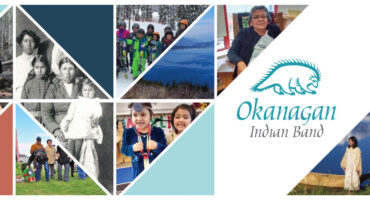Current Work
Language Nest
The Target of the language nest is for children 0 to 5 years of age and mothers. It is full immersion where children and Elders connect through nsqilxʷcen (the language of the sqilxʷpeople) and culture.
The program based on grandma house model. The goal is to ensure a lot of the language use and TPR (total physical response). It is based on how traditionally Grandma would raise/watch children. Women who are pregnant or new mothers attend so baby is introduced to the language from the beginning.
The program has circle times, nature walks with land-based teachings, yoga and learn numbers. The children learn how to prepare traditional food and given traditional foods to eat during this time.
Children do artwork, learn about the food in the language and play in the language. It is important for young people to hear the sounds at a young age. The premise Is not to have a daycare but to ensure that children are absorbed in the language as much as possible. Children’s parent and guardians are required to attend a weekly language program.
Background
The Okanagan Indian Band is part of the Okanagan Nation, which is comprised of 7 Indian Bands, including Lower Similkameen Indian Band, Upper Similkameen Indian Band, Osoyoos Indian Band, Penticton Indian Band, Westbank First Nation, Upper Nicola Indian Band and the Okanagan Indian Band.
Staff are provided professional development to lean the language. The focus is trying to make phrases in the language.
Buddy Program Partnership with nk’mapəlqs i snmamayaʔtn i kel sqilxʷtet)
Once a week, students in Grade 7 mentor young children with supervision from the staff of the program. Some of their activities include:
- Play games.
- Do activities.
- Go for walks.
- Share language through songs, drumming and stories.
The Language and Culture Department have a number of options for getting involved and learning our sqilxʷ language, which are listed below.
Adult and Youth Language classes
An Adult and Youth Language teacher teaches in the community to create speakers and to build a stronger sense of community. Classes focus on nsyilxcən 1 (beginner course- audio, teaching materials, and software to aid learning in 45 lessons) and captíkʷł 1(focuses on vocabulary building, sentence structure, telling stories).
Where are Your Keys Program
Where Are Your Keys? (WAYK) is interactive game that uses gesture and sign language to facilitate communication in the language.
CAN-8
CAN-8 is a virtual lab that improves language learning. It has an online option that can be used at a person’s own speed and schedule.
Cultural Activities
Cultural Activities are and target babies, children, youth, adults, and Elders to access and learn syilx Okanagan cultural protocols and cultural practices using both English and the Nsyilxcen language.
Activities focus on harvest traditional foods and practice culture. The most important part is that community members get to visit. It is offered 2-4 times a month during the evening.
Tupa’s Kitchen
Tupa’s Kitchen is a program teaches families of young children how to prepare healthy traditional foods. It is to reintroduce young children and their families on how to gather and prepare sqilxʷ traditional foods.
Cultural Camps
The Language Nest partners with the Health and Wellness team to deliver two four-day Cultural Camps to the community.
Community’s Language Priorities
- To have language acquisition for staff and community.
- Fluency in the community.
- Higher speaker retention- Elder’s presence, recordings and in the lodge.
- To have a language and cultural committee.
- To record Elders- their phrases and connecting words. It is vocabulary based but sentence structures are the next step.
- To have many avenues with languages and safe places in the community as people learn differently.
Gaps
- Understaffed- there are not enough staff.
- Trying to have more language in the community.
- Support in the communities, i.e. supporting teachers to learn the language who are still teaching.
- Need own language centre as space is rented from other organizations. It would be nice to have a language/cultural building.
- More research needed on language and culture.
- How can we ensure we support youth, the technology changes quickly? How do we get youth to be engaged? i.e. have an app that is hip.
- Lack of communication between programs offered.
- Language support.
- Community mentorship with the language.
- When we look beyond the community, how can we all be on the same level of language all through education throughout the region. We are currently on different levels- some schools teach an hour, some teach less. How can we have a curriculum across the board that supports nation schools.
Resources
The resources- solutions that we would need to bridge that gap:
- Staff
- Support
- Research
- App
- Meeting with other nations, schools, nests to see what we can do
- Recording of Elders
- Have a nation working group
- Relationship building- community to community
- Youth mentorship
- On par with French- receive equivalent funding to learn language
- Healing programs- heal our people before we can move forward. Understand impacts of colonization.
- Learning language and culture, it will have a good impact on them. Understanding why we do things and if it helps.


